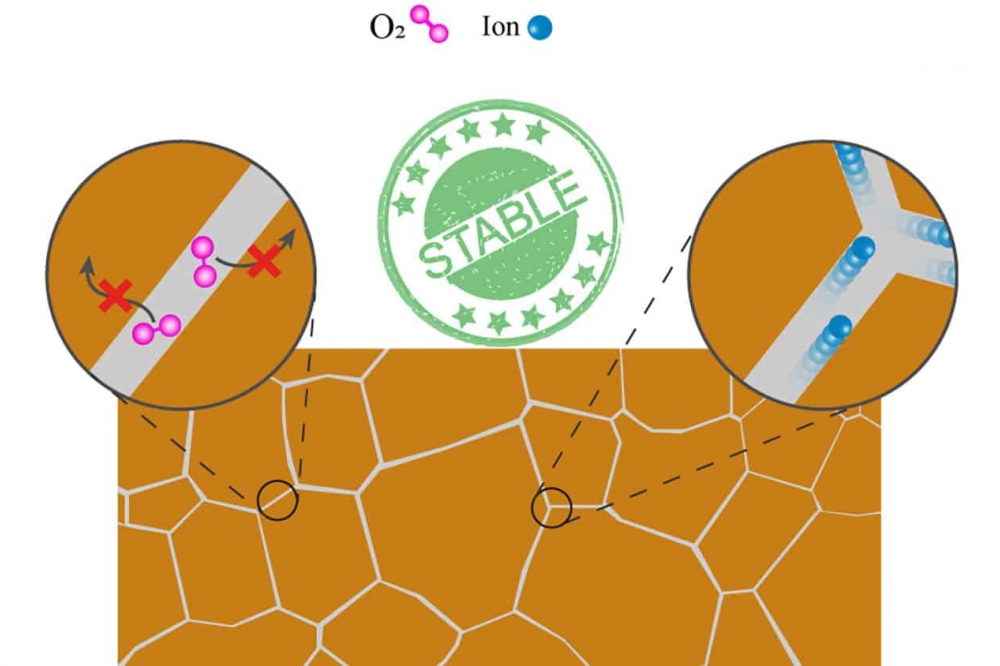Corralling ions improves perovskite stability

Researchers show how stronger grain boundaries can help block migrating ions
Scientists have discovered that channeling ions into defined pathways in perovskite materials improves the stability and operational performance of perovskite solar cells. The finding paves the way for a new generation of lighter, more flexible, and more efficient solar cell technologies suitable for practical use.
“That opens the door to a host of new technologies, such as flexible, lightweight solar cells, or layered solar cells (known as tandems) that can be far more efficient than the solar harvesting technology used today in so-called solar farms,” says Aram Amassian, corresponding author of a paper on the discovery. “There’s interest in integrating perovskite materials into silicon solar cell technologies, which would improve their efficiency from 25 percent to 40 percent while also making use of existing infrastructure.” Amassian is a professor of materials science and engineering at North Carolina State University.
Working with perovskite materials poses a challenge, because – to date – it has not been possible to sustain long term operational stability in perovskite solar cells. When a voltage is applied to a perovskite, it causes ions to migrate through the material. These migrating ions are believed to contribute to chemical and structural changes in the material that ultimately make the materials inefficient and unstable. To make practical perovskite solar cells, researchers need to find a way to address this problem.
“We have not found a way to prevent ions from moving through perovskite materials, but we have found that it is possible to steer these ions into a safe conduit that does not impair the material’s structural integrity or performance,” Amassian says. “It’s a big step forward.”
The safe conduit is a grain boundary. Perovskite materials grow as a series of crystals – or 'grains' – that are flush with each other. These grains are responsible for absorbing light and generating the charges responsible for the electrical current. Each of those grains has the same crystalline structure, but the grains may be oriented in slightly different directions. The area where the grains touch is the grain boundary.
“What we’ve found is that grains are better protected from impairment when the ions move predominantly along the grain boundary,” says first author and co-corresponding author Masoud Ghasemi, a former postdoctoral researcher at North Carolina State who is now a postdoctoral researcher at Penn State.
“Coupling this with what is already known about perovskite materials, it’s clear that problems start when grain boundaries are weak, which makes it easier for ions to move into the grains themselves. Designing stronger grain boundaries that protect the grains is essential to block migrating ions and other harmful species like oxygen from entering the grains, mitigating problematic chemical and structural changes in the material.”
“This is an important insight, because there are established techniques we can use to engineer perovskite materials and their grain boundaries; we can now make use of these approaches to protect the grains,” Amassian says. “We demonstrate how those techniques strengthen grain boundaries in this paper. In short, we now know what needs to be done to make far more stable perovskites.”
The work may also inform the development of more efficient energy storage technologies.
“This work advances our fundamental understanding of how ions move through any crystalline material that can carry charge, not just halide perovskites,” Amassian says. “We’re excited to talk to colleagues who work on energy storage about how this may inform the engineering of faster ion conductors.”
The paper, 'A multiscale ion diffusion framework sheds light on the diffusion–stability–hysteresis nexus in metal halide perovskites' was published in the journal Nature Materials.


































